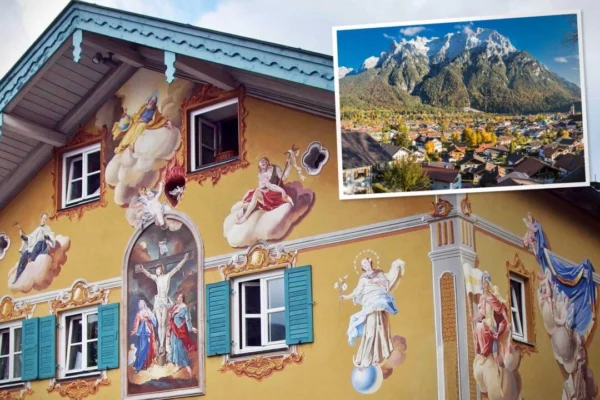A small stream winds its way through the central cobblestone streets of Mittenwald, a town nestled in the Bavarian Alps of Germany, creating an almost fairytale-like, even sacred, scene.
Everywhere in the town, saints, spirits, and gods appear in vibrant colors.
If you happen to travel to Bavaria, you must make a stop here to witness how art, culture, and nature converge at the foothills of the Alps in Mittenwald.
The majestic mountains envelop the colorful, ornate facades of Mittenwald. Fountains gush along the town’s pride, a long arcade that begins at the Parish Church of St. Peter and Paul. At the end of the pavement lies a square with a larger-than-life violin sculpture.
Instrument-making is one of the traditions that Mittenwald is renowned for (local famous violin maker Aegidius Klotz crafted instruments once played by Mozart). Another tradition is its long history of fresco painting. Art that dates back hundreds of years continues to thrive eternally in Mittenwald.
Following the flow of water in the stone channel through the main part of town, Obermarkt, you’ll encounter numerous shops and restaurants adorned with painted stucco. Bright scenes depict heavenly realms, the twelve apostles, angels, cherubs, and other enchanting elements.
These Baroque-style frescoes (“lüftlmalereien”) turn the town into a living storybook. Various small vignettes embellish the entire town, with most portraying vivid biblical themes. By melding perspective techniques with man-made structures, the inspired figures and clouds interweave with windowsills, door frames, beams, balconies, and buildings creating an illusionary harmony.
The preservation of tradition in Mittenwald is indeed magical. For instance, this primitive French painting style known as trompe-l’œil, meaning “deceive the eye,” had its heyday during the 1700s Baroque era. Some frescoes are, in fact, quite ancient. Despite some shifts in techniques and content, locals persist in crafting such scenes.
“Thanks to the original painting techniques, colors can endure for centuries,” painter and sculptor Stephan Pfeffer shared in an email with Epoch Times.
The painting techniques handed down from masters like Titian and Michelangelo demand nimble and deft hands. Artists first apply a thin layer of wet mortar, then paint swiftly on the moist surface. This allows mineral pigments to bond with the plaster substrate, forming a waterproof coat.
This method is known as “fresco painting,” but today’s artists tread the “al secco” path, painting on dried plaster less boldly, and applying modern solutions for waterproofing. However, this doesn’t diminish its artistic appeal.
“Even today, you still need very skilled hands and a great sense of proportion and perspective to create Mittenwald’s frescoes,” Pfeffer remarked.
He and his father Sebastian are renowned in their hometown, adorning many markets and churches with frescoes that grace the winding cobblestone streets of the town.
Just as trade and fashion, facade painting was brought from Italy to German towns by merchants traversing the Alps; Mittenwald once was a major trading hub until other routes opened. The town’s art style was inspired by the flamboyant extravagance of papal painters but became more folk-oriented.
During that time, painting served as a loudspeaker for the public – the Hollywood PR machine of churches. In the fervent anti-religious reform movements of the 18th century, art was used to captivate audiences. The trompe-l’œil illusions of the Baroque era were akin to today’s high-budget movie special effects.
Geniuses like Titian and Bernini almost made the clouds in the grand cathedral seem to descend from the heavens, evoking a sense of eternal transcendence in the common folk. Art was used to win hearts for the Catholic cause.
Drawing inspiration from the famous Baroque movement, the painters of Mittenwald forged a tradition that endures to this day. However, modern sensibilities led to depictions of more secular scenes, such as hunting and rural life.
After spending a morning in the market admiring the splendid frescoes, visitors can relish another long-standing tradition. Pair sausages and pretzel crackers with sweet mustard sauce, and savor locally brewed beer in the company of companions clad in traditional Bavarian attire. Guests can dine under umbrellas by a stream meandering through the town.

